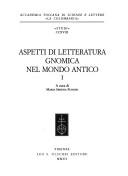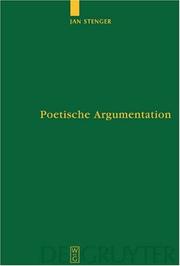| Listing 1 - 4 of 4 |
Sort by
|

ISSN: 00650781 ISBN: 8822254007 8822252152 9788822252159 9788822254009 Year: 2004 Volume: 218 Publisher: Firenze L.S. Olschki
Abstract | Keywords | Export | Availability | Bookmark
 Loading...
Loading...Choose an application
- Reference Manager
- EndNote
- RefWorks (Direct export to RefWorks)
Recueil issu d'une Rencontre sur "Aspetti di trasmissione di letteratura gnomologica e apoftegmatica" tenue près l'École normale supérieure de Pise, du 5 au 7 juin 2003
Gnomic poetry, Greek --- Poésie gnomique grecque --- Poésie gnomique grecque --- History and criticism --- Histoire et critique --- Menander, --- Menander of Athens. Menandrou gnomai --- Congresses --- Gnomic poetry [Greek ] --- Greek literature --- Gnomic poetry, Greek - Congresses.
Book
ISBN: 9782812405747 2812405740 Year: 2012 Volume: 11 Publisher: Paris: Classiques Garnier,
Abstract | Keywords | Export | Availability | Bookmark
 Loading...
Loading...Choose an application
- Reference Manager
- EndNote
- RefWorks (Direct export to RefWorks)
Le Moyen Âge chrétien a réussi à développer sa manière propre de saisir les «parémies» (proverbes, sentences, locutions), de les rendre indispensables à l'éducation religieuse et morale, stimulantes aux arts, attrayantes aux orateurs et à leur conférer ainsi une place significative dans la culture médiévale. Elles deviennent le véritable noyau de la «didactique profane».
Moral education --- Proverbs --- Gnomic poetry --- Education morale --- Proverbes --- Poésie gnomique --- Early works to 1800 --- History and criticism --- Ouvrages avant 1800 --- Histoire et critique --- History --- Poésie gnomique --- History and criticism. --- Moral education - France - History - To 1500 --- Proverbs - History and criticism --- Gnomic poetry - History and criticism
Book
ISBN: 9782503541204 2503541208 Year: 2011 Volume: 4 Publisher: Turnhout: Brepols,
Abstract | Keywords | Export | Availability | Bookmark
 Loading...
Loading...Choose an application
- Reference Manager
- EndNote
- RefWorks (Direct export to RefWorks)
De l'Antiquité à l'Âge classique, des textes toujours plus nombreux et variés se constituent par juxtaposition de brefs énoncés plus ou moins discontinus et supposés dignes de mémoire : adages, proverbes, sentences, aphorismes, apophtegmes, apologuesé, les uns issus, dit-on, d'une tradition populaire immémoriale ('la sagesse des Nations'), les autres attribués avec plus ou moins de certitude et d'exactitude à des auteurs anciens ou modernes. Le 'genre', si tant est qu'il faille parler d'un genre, est particulièrement prisé et fécond à la Renaissance. Le projet dece volume part d'un constat simple quoique troublant : l'immensité du corpus gnomique rassemblé ou composé en Europe entre les XIVe et XVIIIe siècles contraste avec la place minime voire inexistante que lui réservent les travaux d'histoire et de théorie littéraires. Les textes majeurs du genre n'ont que rarement connu des éditions modernes satisfaisantes.
Literary semiotics --- anno 1500-1599 --- anno 1400-1499 --- anno 1300-1399 --- Gnomic poetry --- Maxims --- Aphorisms and apothegms --- European literature --- Poésie gnomique --- Maximes --- Aphorismes et apophtegmes --- Littérature européenne --- History and criticism --- History and criticism. --- Histoire et critique --- 82-84 --- Spreuken. Citaten --- 82-84 Spreuken. Citaten --- Poésie gnomique --- Littérature européenne --- Proverbs --- Latin literature [Medieval and modern ] --- Literature [Medieval ] --- 1450-1600 (Renaissance) --- 17th century --- 82-84 Maxims. Gnomic utterances. Sententiae. Aphorisms. Pithy sayings. Adages. Proverbs. Thoughts. Table-talk. Obiter dicta --- Maxims. Gnomic utterances. Sententiae. Aphorisms. Pithy sayings. Adages. Proverbs. Thoughts. Table-talk. Obiter dicta --- 82-84 Emblemen. Spreuken. Citaten --- Emblemen. Spreuken. Citaten --- Fables --- Latin literature, Medieval and modern --- Literature, Medieval

ISBN: 3110181274 9786613396839 1283396831 3110204789 9783110204780 9783110181272 Year: 2004 Publisher: Berlin ; New York Walter de Gruyter
Abstract | Keywords | Export | Availability | Bookmark
 Loading...
Loading...Choose an application
- Reference Manager
- EndNote
- RefWorks (Direct export to RefWorks)
Die Gnomai in den Epinikien des griechischen Chorlyrikers Bakchylides haben als vermeintlich konventionelles Beiwerk in der Forschung bislang wenig Interesse gefunden. Im Anschluss an ein zunächst entwickeltes Gattungsmodell des Epinikions weist Stenger in Einzelinterpretationen nach, welch zentrale Bedeutung den Gnomai für die Sinnkonstitution im Siegeslied zukommt. Da die Gnomik im Wesentlichen ethisch-moralische Werte vor einem größeren Publikum vertritt, ordnet er sie in einem zweiten Schritt in den zeitgeschichtlichen Kontext des jeweiligen Liedes ein. Erst diese konsequente Historisierung zeigt, dass Bakchylides seine Gnomai geschickt an die verschiedenen soziopolitischen Gegebenheiten und den Erwartungshorizont seines Auditoriums anpasst. Diese Beobachtungen lassen den Kommunikationsprozess chorlyrischer Dichtung zwischen dem Epinikiendichter, seinem Auftraggeber und dem Publikum in einem neuen Licht erscheinen. The Gnomai in the Epinician Odes and Dithyrambs of Bacchylides have hitherto been regarded as an allegedly conventional accompaniment and thus attracted little attention in research. Following the development of a genre model for the epinicion, individual interpretations demonstrate the central significance of the Gnomai in constituting the sense of the Epinicion. As the gnome essentially represents ethical and moral values to a large audience, a second stage of the study relates it to the contemporary historical context of the relevant text. It takes this rigorous contextualisation to show how Bacchylides skilfully fits his Gnomai to the various socio-political factors and the expectations of his audience. These observations cast new light on the communication process in lyrical choral poetry between the composer of the epinicion, his patron and the public.
Gnomic poetry, Greek --- Bacchylides --- Greek gnomic poetry --- Bacchylide --- Bakchylides --- Bakchulides --- Epinikia --- Poésie gnomique grecque --- Greek poetry --- History and criticism. --- Criticism and interpretation. --- History and criticism --- Spreuken --- Histoire et critique --- Criticism and interpretation --- Gnomic poetry [Greek ] --- Vakchylidēs --- Bacchilide --- Bακχυλíδης
| Listing 1 - 4 of 4 |
Sort by
|

 Search
Search Feedback
Feedback About UniCat
About UniCat  Help
Help News
News